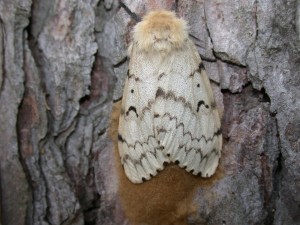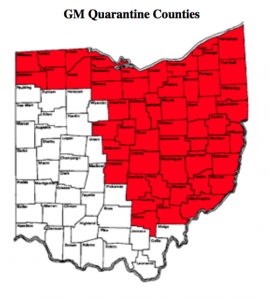
SALEM, Ohio — Gypsy moths have been slowly making their way through the forests of northeastern United States since their accidental release in the New England states more than 100 years ago.
The moths eat away at the leaves of oak trees (their preferred wood), birches, aspens, basswood and more until the tree can no longer take the stress and defoliation begins to occur.

Totally infested
“Pennsylvania has been totally infested (with gypsy moth) since the early ’90s,” said Donald Eggen, forest health manager for the Pennsylvania Department of Conservation and Natural Resources.
“Last year we had over 1 million acres of damage. Just under 7,000 (acres) was due to gypsy moths,” said Eggen. This year, gypsy moth has not been a significant problem in western Pennsylvania but has continued to be a problem in eastern parts of the states and has picked up in central and southern parts of Pennsylvania, he said.
Ohio moth report
“This year we had a little reduction in catches from the previous year,” said David Adkins, gypsy moth program manager at the Ohio Department of Agriculture. Following the 2016 gypsy moth trapping survey project, the total number of catches was just more than 20,000 moths — down 14.6 percent from last years catch, said Adkins.
Traps were placed in 76 of Ohio’s 88 counties and positive catches were reported in 1,650 of the 12,660 traps placed — this is a 13 percent decrease from last year’s moth catch. The highest single trap catch was 700 moths reported in Hancock County, and the highest total catch was reported in Williams County with 3,499 moths.

Wayne County had the highest per trap average at 66.33 moths per trap. Out of the 76 counties surveyed, 27 counties showed increases in the average catch per trap in 2016 versus 2015, where 40 counties had increased catches.
So how did the moths get here?
Pesky background

The European Gypsy Moth was accidentally released in the United States in 1869, when a researcher brought the insect to Massachusetts to breed with a variety of silk worm. The moths escaped the research area and slowly began spreading from the New England and North Atlantic states, to northern North Carolina and west to states surrounding the Great Lakes Region and Iowa.
The moths feed on more than 300 varieties of trees and shrubs and have been a threat to Ohio’s hardwoods since the first moth was trapped in Ashtabula County in 1971. Attempts to eradicate the moths were unsuccessful, and Ashtabula fell under quarantine status.

According to the Ohio Department of Agriculture, 51 Ohio counties are under quarantine regulations. Pennsylvania is completely quarantined.
So how are they controlled in Ohio?
Transition state
The line of gypsy moth movement cuts right through the center of Ohio, dividing the state into three zones of treatment: suppression, slow the spread and eradication, explained Adkins. The goal of the suppression program is to reduce the egg mass count by 80 percent. Treatments are voluntary in these areas.
In 2016, a suppression treatment project was conducted in Seneca County which resulted in a 92 percent reduction in egg masses. “Over the past several years it has been requested by the general public to decrease (spraying) pesticides,” said Adkins, making it challenging to conduct some treatment programs.
Slowing growth
The slow the spread project is a national strategy to manage recently established population of gypsy moth within the project area. The goal is to reduce the overall rate at which the gypsy moth spreads by 60 percent. Two treatments programs occur in these areas: a larvacide treatment and mating disruption treatment.
Larvacide treatments control gypsy moths while they are in the larval or caterpillar stage. Pheromone treatments disrupt the mating process of the gypsy moth. Because the female moths do not fly, they release a pheromone to attract the male moths. When additional pheromones are released in the area, male moths cannot find the females as easily.
Larvacide treatments are usually attempted in late April to early May and pheromone treatments are typically done in mid-June.
Eradication
The final treatment program in Ohio is the eradication treatment project. In these areas, the goal is to eradicate isolated populations that have developed ahead of the transition area. These populations are usually the result of human movement. Successful eradication treatment areas in 2016 included Scioto County and Clermont County in 2015.
Quarantine
Quarantined areas, are areas where gypsy moths have invaded and become permanently established. Gypsy moth quarantines are intended to slow the human-assisted or artificial spread of gypsy moths. Counties under quarantine must take precautions before moving from one area to another — especially if moving to an area that is not already quarantined.
According to the United States Department of Agriculture, Animal Health Inspection Service, you must inspect any outdoor household items for gypsy moth and remove all stages of the moth before a move. Moths will lay their egg sacs on any surface including picnic tables, patio furniture, garden equipment (such as lawn mowers), grills, trailers and vehicles.
To remove egg masses, scrape them from the surface with a putty knife, stiff brush, or other hand tool. Place the eggs a container of hot soapy water or in a sealed plastic bag set in the sun. For more information on gypsy moth quarantine areas and removal, visit the USDA gypsy moth site here.
USDA North America gypsy moth quarantine map
Counties already under quarantine status must go at least three years without a catch to be taken off the quarantine list, explained Adkins.

“Overall it has lightened up a bit,” said Adkins. “We still have a few hotspots along the borders in Williams County and some in Ashland County,” he said.
A late season rain helped with treatment programs and a fungus that kills the gypsy moth.
But according to Adkins, populations can increase and decreased can fluctuate from year to year. “Know what is normal and not normal (with your trees). If you see something different happening, let us know,” said Adkins.
More gypsy moth resources:
- Ohio Department of Agriculture Gypsy Moth page
- Pennsylvania Department of Conservation and Natural Resources
STAY INFORMED. SIGN UP!
Up-to-date agriculture news in your inbox!










